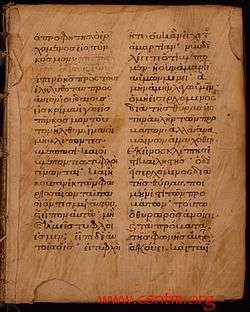Lectionary 313
Lectionary 313 (Gregory-Aland), designated by siglum ℓ 313 (in the Gregory-Aland numbering) is a Greek manuscript of the New Testament, on parchment. Palaeographically it has been assigned to the 14th-century. The manuscript has survived in a fragmentary condition.
| New Testament manuscript | |
 folio 1 recto of the codex | |
| Text | Evangelistarium † |
|---|---|
| Date | 14th-century |
| Script | Greek |
| Found | 1864 |
| Now at | University of Michigan Library |
| Size | 34.5 cm by 28 cm |
| Type | Byzantine text-type |
Description
The codex contains Lessons for selected days only from the Gospels of John, Matthew, Luke lectionary (Evangelistarium) with some lacunae.[1] It is written in Greek minuscule letters, on 209 parchment leaves (34.5 cm by 28 cm), 2 columns per page, 21 lines per page.[2][3] According to the CSNTM description the manuscript has 212 leaves. There are no interesting or significant images.[4]
The codex contains the weekday Gospel Lessons (Evangelistarium) according to the Byzantine Church order.[2][3]
History
Gregory dated the manuscript to the 14th-century.[1] It has been assigned by the Institute for New Testament Textual Research (INTF) to the 14th-century.[2][3]
Of the history of the codex ℓ 313 nothing is known until 1864, when it was in the possession of a dealer at Janina in Epeiros. It was then purchased from him by a representative of Baroness Burdett-Coutts (1814–1906), a philanthropist,[5] together with other Greek manuscripts (among them lectionaries ℓ 314 and ℓ 315)[1] which were transported to England in 1870–1871.[6]
The manuscript was added to the list of New Testament manuscripts by F. H. A. Scrivener (494) Caspar René Gregory (number 313e).[1]
It used to be held in London (Burdett-Coutts II. 5).[1] The codex is now housed in the University of Michigan Library (Ms. 33) in Ann Arbor.[2][3]
The manuscript is not cited in critical editions of the Greek New Testament (UBS4,[7] NA28[8]).
Notes and references
- Gregory, Caspar René (1900). Textkritik des Neuen Testaments. 1. Leipzig: J.C. Hinrichs’sche Buchhandlung. p. 414.
- Aland, Kurt; M. Welte; B. Köster; K. Junack (1994). Kurzgefasste Liste der griechischen Handschriften des Neues Testaments. Berlin, New York: Walter de Gruyter. p. 238. ISBN 3-11-011986-2.
- "Liste Handschriften". Münster: Institute for New Testament Textual Research. Retrieved 29 September 2013.
- Images of lectionary 313 at the CSNTM
- Parker, Franklin (1995). George Peabody, a biography. Vanderbilt University Press. p. 107.
- Robert Mathiesen, An Important Greek Manuscript Rediscovered and Redated (Codex Burdett-Coutts III.42), The Harvard Theological Review, Vol. 76, No. 1 (Jan., 1983), pp. 131–133.
- Aland, B.; Aland, K.; J. Karavidopoulos, C. M. Martini, B. Metzger, A. Wikgren (1993). The Greek New Testament (4 ed.). Stuttgart: United Bible Societies. p. 21*. ISBN 978-3-438-05110-3.CS1 maint: multiple names: authors list (link)
- Nestle, Eberhard et Erwin (2001). Novum Testamentum Graece. communiter ediderunt: B. et K. Aland, J. Karavidopoulos, C. M. Martini, B. M. Metzger (27 ed.). Stuttgart: Deutsche Bibelgesellschaft. p. 814. ISBN 978-3-438-05100-4.
Bibliography
- Gregory, Caspar René (1900). Textkritik des Neuen Testaments. 1. Leipzig: J.C. Hinrichs’sche Buchhandlung. p. 414.
External links
| Wikimedia Commons has media related to Lectionary 313. |
- Images of lectionary 313 at the CSNTM